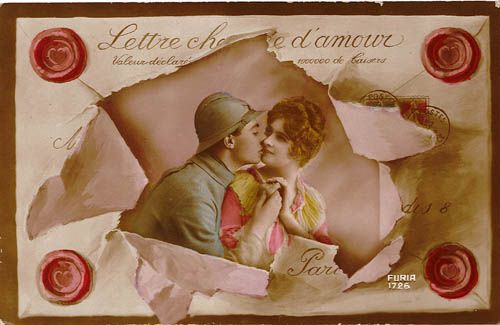Une exposition présentée dans le cadre du Mois de la Photo à Paris à l'occasion du centenaire de la Grande Guerre.
This post is also available in:
 French
French
… Behind these masks, this bunting, these painted façades, it is impossible to imagine the life in the trenches, the mud, the rats, the gunfire, the explosions, the horror of war with its mortars and other machines that would shake you to your bones. Butchery that the words scribbled on the back of these postcards never mentioned. It is always “I’m OK”, “don’t be worried”, “everything’s fine here” and only rarely “we’re terribly bored”.
Gérard MordillatThe First World War mobilised more than eight million fighters in France, (20 % of the population), of whom 1.4 million died (1000 every day), and three million were injured (2000 every day)…
During the fifty-one months of combat, separation and anxiety, these letters played an essential role linking the soldiers and their loved ones. Those back home used them to show that they were thinking of those on the front, while for the soldiers, they were the means of showing that they were simply still alive!
The two conditions of this massive correspondence were literacy and the existence of a public postal service. For the first time in military history, most of the soldiers and civilians of their age could read and write: in fact they had benefited from a primary education made free and mandatory thirty-odd years beforehand by the laws of Jules Ferry. Their often elementary learning was enough to keep up a basic correspondence.
As for the public postal service, it was in 1914 exactly as it had been when it was created during the 19th century with its principal functional and human features (mandates, registered mail, postcards, stamps, the mail train, post offices and the jobs of postman and teller…).
Postcards made up a significant proportion of the mail because they allowed for brief and rapid exchanges, better adapted than letters to the prevailing conditions.
Between 1914 and 1918, several billion postcards were written. They fall into two categories:
– factual postcards with photographs representing the effects of the war (devastated battlefields, civilian ruins, military cemeteries…), along with portraits of generals or of groups of injured soldiers in ramshackle field hospitals
– « fantasy » postcards – coloured-in photomontages – made up only in part of images of kisses, surprisingly neglected by collectors despite their originality and their unequalled representation of the kiss in the history of graphic images.
The celebration of the centenary of the Great War is the moment to bring these postcards of tender thoughts to the fore, composed quickly by men and women who often could barely spell, full of banalities aimed at reassuring the addressees. They are the relics of love. Michel Christolhommewww.baisers-de-guerre.wix.com/baisersdeguerre
From 10/11/2014 to 27/12/2014
Galerie FAIT & CAUSE
58 rue Quincampoix
75004 Paris
France
Opening hours : Du mardi au samedi de 13h30 à 18h30
Phone : 00 33 (0)1 42 74 26 36
contact@sophot.com
www.sophot.com



